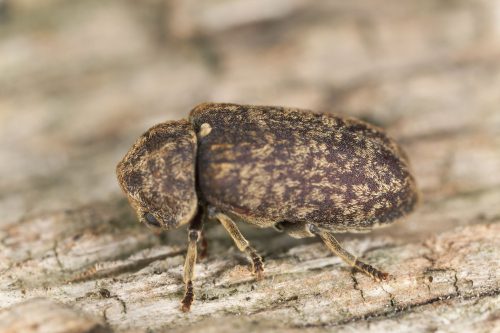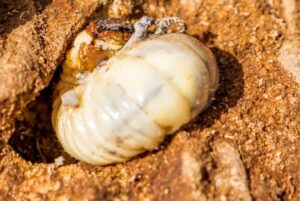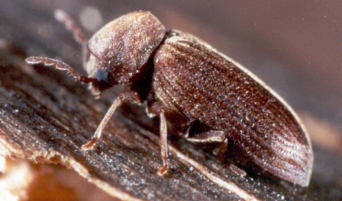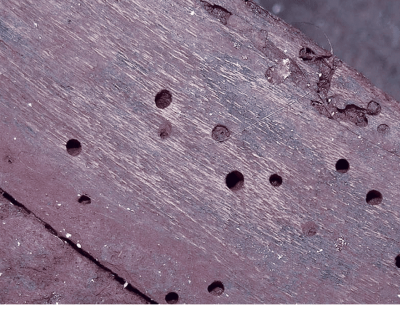
Anobiid beetles
Anobiid beetles, also known as furniture beetles, are a family of beetles capable of damaging and infesting both hard and softwood.
Two of the most common types of anobiids are the Anobium punctatum (common furniture beetle) and the Euvrilletta peltata beetles.
Although there are many different kinds of anobiid beetles, very few of them actually infest wood. For those who do, it is not the adults but their larvae who feed on the wood as they develop inside. Understanding how to distinguish the type of beetle infesting the wood can help the homeowner better control the problem.
How to identify an anobiid beetle
Adult anobiid beetles are reddish-brown to dark brown in color and are fairly small, measuring around ⅛ to ¼ inch long. Their body shape ranges from thin and long to oval, with a head directed downwards, covered by a hoodlike pronotum. If viewed from above, their heads are not visible due to this downwards position of the head. These beetles have winged bodies. The larvae, on the other hand, are light colored and C-shaped with three pairs of small legs. When adult anobiids emerge from the wood, they bore circular exit holes about 1/16 to ⅛ inch in diameter.


When it comes to identifying the signs of anobiid beetles there are a few specific things to look for. Since they attack both hard and softwoods, they could potentially attack any of the wood in the home, from furniture to structural elements. Hardwoods like maple, beech, magnolia, and yellow poplar are particularly susceptible to anobiid attacks due to their porous nature. Small, round exit holes and piles of frass can be indicators of an infestation. And while they might infest both hard and softwoods, anobiids require specific conditions in order to thrive.
Anobiid beetles vs. Cigarette beetles
Due to their similar appearance, Anobiids are often confused with cigarette beetles that also live in homes. Cigarette beetles are light to dark brown (although sometimes described as reddish) and measure about ⅛” in length. Much like Anobiids, cigarette beetles also have rounded oval-shaped bodies and their heads are covered by the pronotum. Cigarette beetles also possess antennae that are serrated much like a knife or saw. The biggest difference between the two is that unlike Anobiids, Cigarette beetles are not wood borers. Instead, as their name would suggest, Cigarette beetles attack tobacco and tobacco products. They also tend to attack stored products such as grains and flours, various spices, and even dried plants.
Anobiid beetle habits
Regardless of the type of wood, anobiids prefer wood with a 13-30% moisture content which is necessary for larval development. In addition to the moisture content, high humidity is needed for eggs to even hatch. Eggs need above 60% humidity in order to hatch, below that and the number of hatched eggs becomes zero. It is because of this that anobiids are most commonly found in crawl spaces, basements, and garages around the country. Structural infestations however, are more concentrated to regions with high humidity and temperatures found in the southeastern and coastal states.
Anobiid beetle larvae
Not only do anobiids attack both wood types, but they are also able to digest cellulose (unlike lyctids and bostrichids). Consequently, they are able to infest wood regardless of age, including buildings that are centuries old. In many cases, and because the infestations develop slowly, infestations are usually found in homes older than 10 years. Another side effect of their ability to digest cellulose is the possibility of reinfestation. Since anobiids do not rely solely on the nutrients and starch found in wood, this allows adults to reinfest wood year after year. Given favorable conditions, anobiid larvae may only take a year or two to develop. In other cases it may take up to 5 years and some larvae may die, depending on the moisture content. The average anobiid life cycle lasts anywhere between 1 to 3 years.
And as the larvae eat through and develop inside the wood, they also produce frass, a mixture of wood and excrement. Due to the variety of wood they inhabit, the texture of frass varies based on the type of wood. When larvae feed on softwood, frass is a yellow-white powder with oblong pellets giving it a gritty feel. However, when hardwood is attacked, the frass is finer, more tightly packed, and has fewer pellets. A closer inspection of the frass may also help indicate if treatment is necessary or not. For example, fresh, fluffy-looking frass apparent in large quantities could mean active feeding larvae.
Learn how to treat for powderpost beetles in structural wood
